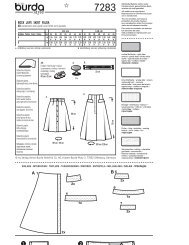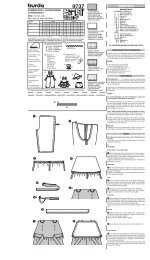MANTEL MANTEAU COAT ABRIGO - Outlet für Stoffe und Styling
MANTEL MANTEAU COAT ABRIGO - Outlet für Stoffe und Styling
MANTEL MANTEAU COAT ABRIGO - Outlet für Stoffe und Styling
Erfolgreiche ePaper selbst erstellen
Machen Sie aus Ihren PDF Publikationen ein blätterbares Flipbook mit unserer einzigartigen Google optimierten e-Paper Software.
teils aber auf keinen Fall eine Kante oder Naht. Das Teil wird doppelt<br />
so groß zugeschnitten, dabei bildet der Stoffbruch die Mittellinie.<br />
FOLD ( ) means: Here is the center of a pattern piece but in<br />
no case a cut edge or seam. The piece should be cut double, with the<br />
fold line forming the center line.<br />
Si, sur le plan de coupe, la pièce est tracée avec une ligne discontinue,<br />
placez la face imprimée du papier dessous, contre le tissu.<br />
Schnittteile mit unterbrochener Konturlinie auf dem Zuschneideplan<br />
werden mit der bedruckten Seite nach unten auf den Stoff gelegt.<br />
Die Zuschneidepläne auf dem Schnittbogen zeigen die Anordnung<br />
der Schnittteile auf dem Stoff.<br />
Bei einfacher Stofflage die Schnittteile auf die rechte Seite stecken.<br />
Bei doppelter Stofflage liegt die rechte Seite innen. Teile auf die linke<br />
Seite stecken. Die Teile, die auf dem Zuschneideplan über dem<br />
Stoffbruch liegen, zuletzt bei einfacher Stofflage zuschneiden.<br />
NAHT- UND SAUMZUGABEN müssen zugegeben werden:<br />
4 cm Saum <strong>und</strong> Ärmelsaum, 1,5 cm an allen anderen Kanten <strong>und</strong><br />
Nähten.<br />
Mit Hilfe von BURDA Kopierpapier die Schnittkonturen (Naht- <strong>und</strong><br />
Saumlinien) <strong>und</strong> die in den Teilen eingezeichneten Linien <strong>und</strong> Zeichen<br />
auf die linke Stoffseite übertragen. Eine Anleitung finden Sie in<br />
der Packung.<br />
EINLAGE<br />
Einlage laut Zeichnungen zuschneiden <strong>und</strong> auf die linke Stoffseite<br />
bügeln. Zusätzlich 4 cm breite Einlagestreifen auf die Saumzugabe<br />
der Vorder-, Rücken- <strong>und</strong> Ärmelteile bügeln. Schnittkonturen auf die<br />
Einlage übertragen.<br />
FUTTER<br />
Futter nach den Teilen 4, 7, 8, 9 <strong>und</strong> 14 bis 16 zuschneiden.<br />
Siehe Zuschneidepläne auf dem Schnittbogen.<br />
Naht- <strong>und</strong> Saumzugaben müssen zugegeben werden:<br />
1,5 cm an allen Kanten <strong>und</strong> Nähten.<br />
Schnittkonturen auf die Futterteile übertragen.<br />
NÄHEN<br />
Beim Zusammennähen liegen die rechten Stoffseiten aufeinander.<br />
Alle Linien in den Schnittteilen mit Heftstichen auf die rechte<br />
Stoffseite übertragen.<br />
CREATIVMODELL<br />
Zuerst die Quernähte an den mittl. <strong>und</strong> seitl. Vorderteilen sowie an<br />
den mittl. <strong>und</strong> seitl. Rückenteilen steppen. Dann die unterschiedlichen<br />
Borten entlang der Nähte aufsteppen.<br />
Anschließend den Mantel laut Anleitung zusammennähen.<br />
Beim Kragen haben wir den Kragensteg als Stehkragen verwendet<br />
<strong>und</strong> in Kragenmitte ein Band aufgesteppt.<br />
Als Verschluss haben wir große Druckknöpfe in der vord. Mitte auf<br />
den Besatz des rechten Vorderteils <strong>und</strong> auf die linke vord. Kante genäht.<br />
<strong>MANTEL</strong><br />
Brustabnäher Gr. 50 bis 58<br />
Brustabnäher der mittl. Vorderteile spitz auslaufend steppen. Fäden<br />
verknoten. Abnäher nach unten bügeln.<br />
Vord. Teilungsnähte / Nahttaschen<br />
Futtertaschenbeutel rechts auf rechts auf die mittl. Vorderteile,<br />
Stofftaschenbeutel auf die seitl. Vorderteile heften, Querstriche treffen<br />
aufeinander. Steppen. Nahtenden sichern. Taschenbeutel über<br />
die Ansatznähte bügeln (2a).<br />
Seitl. Vorderteile rechts auf rechts auf die mittl. Vorderteile legen,<br />
Teilungsnähte heften (Nahtzahl 2). Bei Gr. 44 bis 48 die mittl.<br />
Vorderteile zwischen den etwas einhalten. Teilungsnähte steppen,<br />
dabei die Tascheneingriffe zwischen den Querstrichen nicht zusteppen,<br />
aber noch geheftet lassen. Nahtenden sichern.<br />
Nahtzugaben <strong>und</strong> Taschenbeutel in die seitl. Vorderteile bügeln.<br />
Mittl. Vorderteile an den Tascheneingriffen wie markiert absteppen.<br />
Tipp: Evtl. vorher einen Einlagestreifen aufbügeln.<br />
Nahtzugaben auseinanderbügeln. Taschenbeutel in die mittl.<br />
Vorderteile bügeln, aufeinanderheften <strong>und</strong> -steppen.<br />
Rückw Mittelnaht / Schlitz<br />
Linkes Rückenteil 1,5 cm neben der markierten Linie LINKS<br />
KANTE zurückschneiden.<br />
Rückenteile rechts auf rechts legen. Mittelnaht von oben bis unten<br />
heften, von oben bis zum Schlitzzeichen steppen. Nahtenden sichern.<br />
Schlitz noch geheftet lassen. Das rechte Rückenteil am Untertrittende<br />
bis zur Stepplinie einschneiden (Pfeil).<br />
Pattern pieces outlined with a broken line in the cutting layout are to<br />
be placed face down on the fabric.<br />
The cutting layouts on the pattern sheet show how the pattern<br />
pieces should be placed on the fabric.<br />
For a single layer of fabric, the pattern pieces are pinned to the right<br />
side. For double layers of fabric, right sides are facing and the pattern<br />
pieces are pinned to the wrong side. Pattern pieces shown extending<br />
over the fabric fold should be cut last from a single layer of fabric.<br />
SEAM AND HEM ALLOWANCES must be added to the pattern<br />
pieces:<br />
1⅝" (4 cm) for hem and sleeve hem, ⅝" (1.5 cm) at all other seams<br />
and edges.<br />
Use BURDA carbon paper to transfer the pattern outlines (seam and<br />
hem lines) and all other lines and markings to the wrong side of the<br />
fabric pieces according to package instructions.<br />
INTERFACING<br />
Cut interfacing as illustrated and iron on the wrong side of the fabric<br />
pieces. Also iron strips of interfacing 1⅝" (4 cm) wide on the hem<br />
allowance of front, back and sleeve pieces. Transfer pattern piece<br />
outlines to the interfacing pieces.<br />
LINING<br />
Use pieces 4, 7, 8, 9 and 14 to 16 to cut the lining.<br />
See cutting layouts on pattern sheet.<br />
Seam and hem allowances must be added to the pattern pieces:<br />
⅝" (1.5 cm) at all seams and edges.<br />
Transfer pattern piece outlines to the lining pieces.<br />
SEWING<br />
When sewing, right sides of fabric should be facing.<br />
Transfer all pattern lines to the right side of the fabric with basting<br />
thread.<br />
CREATIVE STYLE<br />
First stitch the crosswise seams on the center and side front pieces<br />
as well as on the center and side back pieces. Then stitch various<br />
trims on along the seams.<br />
Now follow the sewing instructions below.<br />
We used the collarband as a stand collar and stitched a band of trim<br />
along the middle of the collar.<br />
We fastened the coat with large snap fasteners sewn on in center<br />
front of right facing and on left front edge of coat.<br />
<strong>COAT</strong><br />
Bust Darts Sizes 24 to 32 (50 to 58)<br />
Stitch bust darts on center front pieces toward points of darts.<br />
Knot ends of thread. Press darts down.<br />
Front Panel Seams / Pockets in Seams<br />
Baste pocket lining pieces right sides together with center front<br />
pieces. Baste fabric pocket pieces on side fronts, matching markings.<br />
Stitch. Secure ends of stitching. Press pocket pieces over joining<br />
seams (2a).<br />
Lay side fronts right sides together with center fronts. Baste<br />
panel seams (seam number 2). For sizes 18 to 22 (44 to 48), ease<br />
center fronts a bit between the . Stitch panel seams, not stitching<br />
across pocket openings but leave pocket openings basted. Secure<br />
ends of stitching.<br />
Press seam allowances and pocket pieces onto side fronts. Topstitch<br />
center fronts at pocket opening edges as marked.<br />
Tip: We recommend you iron on a strip of interfacing first.<br />
Press seam allowances open. Press pocket pieces onto center<br />
fronts, baste and stitch together.<br />
Center Back Seam / Slit<br />
Trim left back ⅝" (1.5 cm) next to line marked LEFT EDGE.<br />
Lay back pieces right sides together. Baste center seam from<br />
upper to lower edges. Stitch seam from upper edges to slit mark.<br />
Secure ends of stitching. Leave slit basted. Clip right back at end of<br />
<strong>und</strong>erlap close to stitching line (arrow).<br />
Les plans de coupe sur la planche à patrons indiquent comment<br />
disposer les pièces en papier sur le tissu<br />
Epinglez les pièces du patron sur l‘endroit du tissu pour les couper<br />
dans l‘épaisseur simple du tissu, sur l‘envers pour les couper dans<br />
l‘épaisseur double. En dernier lieu, coupez dans l‘épaisseur simple<br />
les pièces qui, sur le plan de coupe, dépassent la pliure du tissu.<br />
Il faut ajouter les SURPLUS DE COUTURE ET D‘OURLET:<br />
4 cm pour l‘ourlet et les ourlets de manche, 1,5 cm à tous les autres<br />
bords et coutures.<br />
Avec le papier graphite copie-couture BURDA, reportez sur l‘envers<br />
du tissu les contours du patron (lignes de couture et lignes d‘ourlet)<br />
ainsi que les lignes et repères indiqués à l‘intérieur des pièces. Une<br />
notice explicative est jointe à la pochette.<br />
ENTOILAGE<br />
Coupez l‘entoilage selon les croquis et thermocollez-le sur l‘envers<br />
du tissu. Thermocollez également des bandes d‘entoilage de 4 cm<br />
de large sur le surplus d‘ourlet des devants, des dos et des manches.<br />
Reportez les contours du patron sur l‘entoilage.<br />
DOUBLURE<br />
Coupez les pièces 4, 7, 8, 9, 14, 15 et 16 dans la doublure.<br />
Basez-vous sur les plans de coupe de la planche à patrons.<br />
Il faut ajouter les surplus de couture et d‘ourlet:<br />
1,5 cm à tous les bords et coutures.<br />
Reportez les contours du patron sur la doublure.<br />
L‘ASSEMBLAGE DES PIÈCES<br />
Pour coudre deux pièces ensemble, veillez à les superposer,<br />
endroit contre endroit.<br />
Bâtissez toutes les lignes indiquées à l‘intérieur des pièces afin<br />
qu‘elles soient visibles sur l‘endroit du tissu.<br />
MODELE CREATIF<br />
Piquer d‘abord les coutures horizontales sur les milieux et les côtés<br />
devant ainsi que sur les milieux et côtés dos. Puis, fixer les différents<br />
galons le long des coutures.<br />
Ensuite assembler le manteau en suivant l‘explication.<br />
Pour le col, nous avons utilisé le pied de col en guise de col droit et<br />
piqué un ruban au milieu du col.<br />
En guise de fermeture, nous avons cousu de gros boutons-pression<br />
suivant la ligne milieu devant sur la parementure du devant droit et<br />
sur le bord devant gauche.<br />
<strong>MANTEAU</strong><br />
Pinces de poitrine t. 50 à 58<br />
Piquer les pinces de poitrine sur les milieux devant en les effilant.<br />
Nouer les fils de piqûre. Coucher les pinces vers le bas, repasser.<br />
Coutures de découpe devant / poches prises dans les coutures<br />
Poser les fonds de poche en doublure end. contre end., sur les milieux<br />
devant, bâtir les fonds de poche en tissu sur les côtés devant, superposer<br />
les repères. Piquer. Assurer les extrémités de couture.<br />
Coucher les fonds de poche sur les couture de montage, repasser (fig.<br />
2a).<br />
Poser les côtés devant, endroit contre endroit, sur les milieux devant,<br />
bâtir les coutures de découpe (chiffe 2). Pour les t. 44 à 48 soutenir<br />
les milieux devant entre . Piquer les cout. de découpe, ne pas<br />
fermer les fentes de poche entre les repères transversaux, ne pas défaire<br />
le bâti des fentes. Assurer les extrémités de cout. Ecarter les surplus<br />
au fer.<br />
Coucher les surplus et fonds de poche sur les côtés devant, repasser.<br />
Surpiquer les milieux devant aux fentes de poche selon le tracé.<br />
Conseil: thermocoller évent. au préalable une bande d‘entoilage.<br />
Ecarter les surplus de couture au fer. Coucher les fonds de poche<br />
sur les milieux devant, repasser, les bâtir et les piquer ensemble.<br />
Couture milieu dos / fente<br />
Réduire le dos gauche à 1,5 cm du tracé portant la mention<br />
BORD A GAUCHE.<br />
Poser les dos, endroit contre endroit. Bâtir la couture milieu, du<br />
bord supérieur au bord inférieur, la piquer du bord supérieur au<br />
repère de fente. Ne pas défaire le bâti de la fente à ce stade. Cranter<br />
le dos droit à l‘extrémité de la sous-patte au ras des points (flèche).




